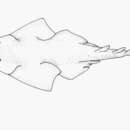Diagnostic Description
provided by FAO species catalogs
fieldmarks: An angelshark with a broad trunk, dorsal spines weak or absent, heavily fringed nasal barbels and anterior nasal flaps, lateral dermal folds of head without triangular lobes, and no large ocelli on body. Trunk very broad. Anterior nasal barbels strongly fringed; posterior margin of anterior nasal flaps between nasal barbels and tips strongly fringed; distance from eye to spiracle at least 1.5 times eye diameter; dermal folds on sides of head without triangular lobes. Origin of first dorsal fin usually about opposite pelvic rear tips; pectoral fins rather short and high, free rear tips narrowly subangular. No large spines on midline of back and tail or on snout and above eyes; lateral trunk denticles without ridges. No ocelli on body, but with numerous small, symmetrical, white spots.
- bibliographic citation
- FAO species catalogue Vol.4. Sharks of the world. An Annotated and Illustrated Catalogue of Shark Species Known to Date Part 1 - Hexanchiformes to Lamniformes. Compagno, L.J.V.1984FAO Fisheries Synopsis. , (125) Vol.4, Part 1.
- author
- Food and Agriculture Organization of the UN
Distribution
provided by FAO species catalogs
Western South Pacific: Australia (South and Western Australia, New South Wales, Tasmania, Victoria).
- bibliographic citation
- FAO species catalogue Vol.4. Sharks of the world. An Annotated and Illustrated Catalogue of Shark Species Known to Date Part 1 - Hexanchiformes to Lamniformes. Compagno, L.J.V.1984FAO Fisheries Synopsis. , (125) Vol.4, Part 1.
- author
- Food and Agriculture Organization of the UN
Size
provided by FAO species catalogs
Maximum total length about 152 cm.
- bibliographic citation
- FAO species catalogue Vol.4. Sharks of the world. An Annotated and Illustrated Catalogue of Shark Species Known to Date Part 1 - Hexanchiformes to Lamniformes. Compagno, L.J.V.1984FAO Fisheries Synopsis. , (125) Vol.4, Part 1.
- author
- Food and Agriculture Organization of the UN
Brief Summary
provided by FAO species catalogs
A common but tittle-known angelshark of the continental shelf and uppermost slope, on or near bottom,from close inshore to 256 m depth. Ovoviviparous.
- bibliographic citation
- FAO species catalogue Vol.4. Sharks of the world. An Annotated and Illustrated Catalogue of Shark Species Known to Date Part 1 - Hexanchiformes to Lamniformes. Compagno, L.J.V.1984FAO Fisheries Synopsis. , (125) Vol.4, Part 1.
- author
- Food and Agriculture Organization of the UN
Benefits
provided by FAO species catalogs
Taken by bottom trawlers in Australia. Utilization unknown.
- bibliographic citation
- FAO species catalogue Vol.4. Sharks of the world. An Annotated and Illustrated Catalogue of Shark Species Known to Date Part 1 - Hexanchiformes to Lamniformes. Compagno, L.J.V.1984FAO Fisheries Synopsis. , (125) Vol.4, Part 1.
- author
- Food and Agriculture Organization of the UN

